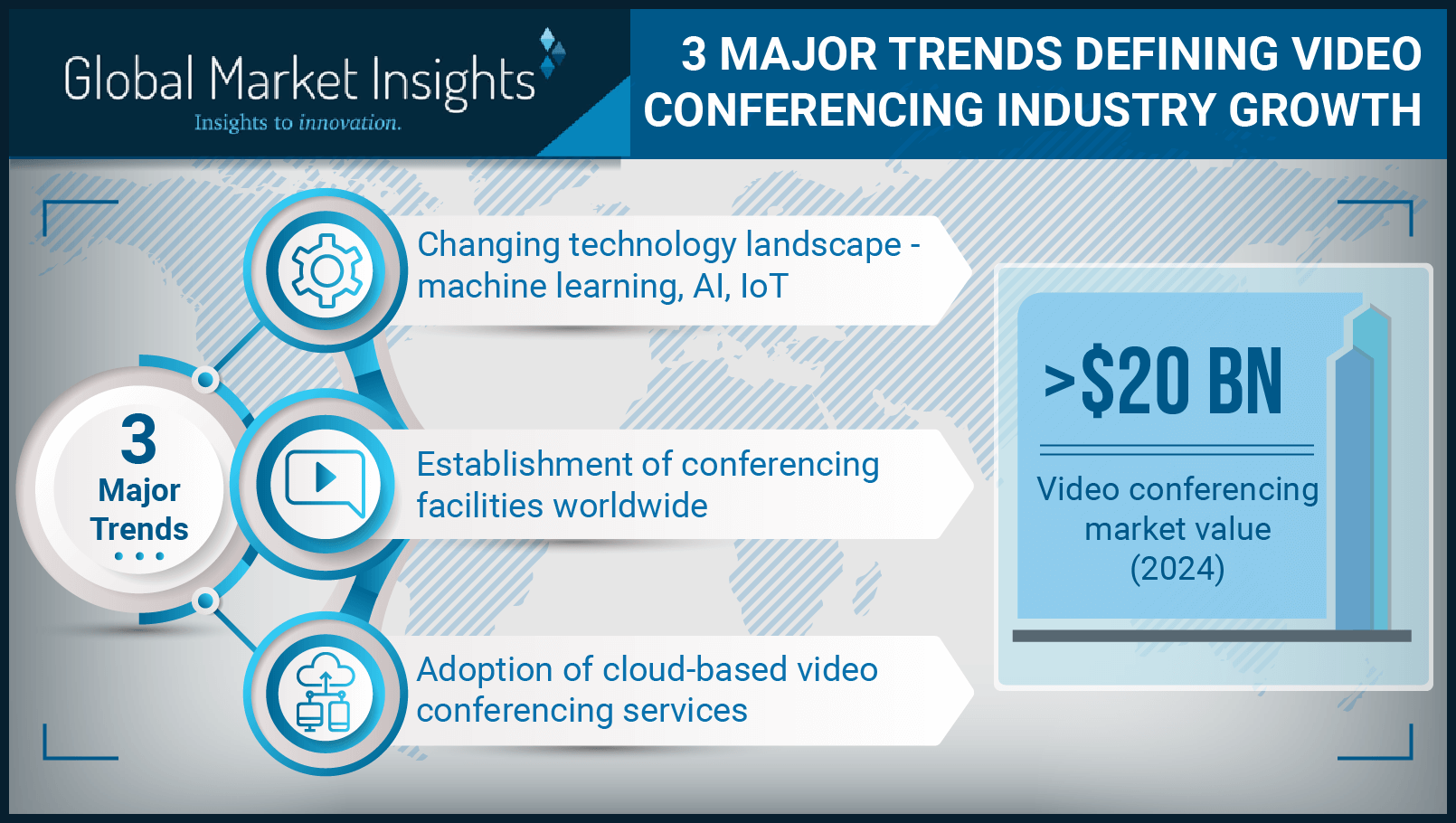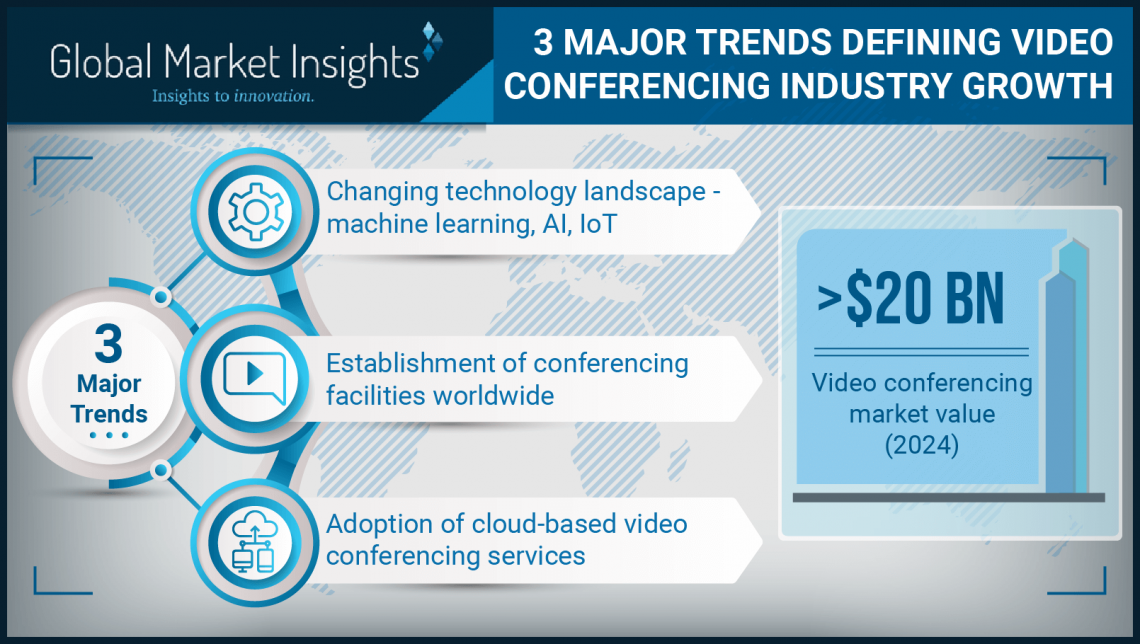The proliferating expansion of video conferencing industry is rather evident from the recent launch of Sync, a monitoring and management software by Logitech. Armed with an intent to help enterprises easily manage their video conferencing systems, Logitech’s entry in conference device management comes on the heels of discussions in meeting rooms shifting toward video modes. On the grounds of this paradigm shift, numerous video conferencing service providers have been striving to up their ante as far as product advancements are considered, thereby providing a positive impetus to video conferencing market size.
The rising industrialization and globalization trends have majorly impacted the demand for video conferencing solutions, given that the technique is one of the more effective modes of communication for executing prompt decision-making. The use of this mode of communication not only increases work efficiency but also brings about a reduction in the overall costs associated with non-virtual meetings, making it one of the most doted technologies of the last decade.

Presently, it has been observed that the rising implementation of technological innovations has left most enterprises with little choice other than to develop and use modern conference rooms equipped with the facilities of reliable and flexible video conferencing solutions. As the implementation of a virtual mode of communication is streamlined for effectively enabling convenient employee communication, the global video conferencing industry size is likely to depict an uproar.
The advantages of video conferencing are rather numerous – the technology offers tangible and non-tangible benefits to businesses. While the former is inclusive of lesser travel costs (especially during employee training), the latter includes efficient non-verbal communication. Taking into account the security, stability, and reliability of video conferencing solutions and their ability to quicken the pace of decision-making to enhance productivity with low investments, tech companies and other business personnel have been depicting increasing interest in tapping teleconferencing trends.
1)Changing technology landscape and its impact on video conferencing industry share
The influx of various technologies, prime among them being machine learning, AI, IoT, etc., have had a path-breaking influence on the adoption of video conferencing solutions. Technology companies like Apple, Google, and Microsoft are seen extensively leveraging video conferencing technology and bringing forth a plethora of new advancements in the product formulation.
As the approach of corporate businessowners with respect to modern communication systems and their implementation at the workplace changes, the deployment of video conferencing solutions for video meetings, group webinars, and enterprise-level discussions in the corporate spectrum is bound to become commonplace.
The advantages of video conferencing in tandem with the integration of AI in these solutions has been recognized by most business owners – say for instance, the amalgamation of AI and computing vision will help bring about enhanced detection of visual obstacles and eventually, help optimize light balance. Similarly, video conferencing solutions embedded with smart camera control will help track humans present in the room via automatic camera panning. Pertaining to the aforesaid advantages of video conferencing and the penetration of advanced technology, the adoption graph of this software is likely to incline in the years ahead, pushing teleconferencing trends. The trend is validated with the surging demand graph of unified communications & collaboration (UCC) market, which is slated to surpass USD 60 billion by 2025.
A couple of other instances depicting the integration of tech advancements in conferencing aids includes the launch of Google’s hangout, Apple’s FaceTime, and Microsoft’s Skype – all of which have been embedded with patented gesture recognition features.
Considering the increasing scope of the video conferencing aids, tech magnates have been emptying their coffers to miniaturize the devices equipped with video conferencing support for ease of handling and portability. Tablets, smartphones, and portable laptops are now integrated with full-fledged teleconferencing software.
The recent launch of Google’s Pixel is an example of a device validating the integration of video conferencing aids and miniaturization of web conferencing devices. The device is also incorporated with a high-quality front camera and 1080p video capturing quality which can be acceptable for video conferencing.
2)The establishment of conferencing facilities worldwide and its impact on video conferencing market outlook
Given that video conferencing technology adoption helps save time and costs, most of the countries have been undertaking initiatives to establish teleconferencing facilities. Apart from corporate workspaces, another avenue where this technology would gain momentum is the research community across the globe.
Say for instance, if a certain research project requires inputs from scientists who stay far away from the actual workplace, the person would still be able to be a part of the project deliverables sans the physical presence; courtesy – the presence of video conferencing facilities. Thus, in order to avoid unnecessary delays in project executions and to accelerate R&D programs to steer the nation on the path of scientific and economic progress, regional governments have also been upping their ante to develop video conferencing facilities and propel teleconferencing trends over the years ahead.
Validating the aforementioned fact, more than a year back, the Chief Minister of one of the Indian provincial states, Himachal Pradesh, inaugurated a newly developed video conferencing facility through state innovation funds at the local forensic science laboratory. Experts claim that the deployment of such a video conferencing facility would save the time spent on the analysis and transit of criminal cases. Numerous enterprises and research institutes have also been working to utilize innovative ways of communication for myriad applications, thereby generating novel growth opportunities in the video conferencing industry.
3)The deployment of the cloud and its impact on the adoption of video conferencing systems
The prevalence of the cloud has brought forth a spate of changes in the way teleconferencing trends are being perceived. Recently, one of the video conferencing service provider, Videxio initiated a merger agreement with the software-assisted meeting platform, Pexip, in order to upsurge the adoption of cloud-based video conferencing services. The rising popularity of the cloud is thus one of the most prominent factors that has encouraged companies to adopt partnership tactics and deliver top notch services in video conferencing industry.
It has been observed in fact, that most IT companies have now adopted cloud-based visual conferencing solutions, owing to their flexibility and scalability. The integration of video conferencing technologies in the IT network has also had a lucrative impact on the web conferencing market size. Elaborating on the aforesaid, the duo, Pexip and Vidxio are even planning to introduce innovative and broader ranges of their products to attract more consumers. Having recognized that a diversified customer base is the key to industry expansion, technology companies have been working to develop robust and sustainable conferencing facilities, thereby pushing teleconferencing trends globally.
Speaking of yet another instance of the cloud proliferating video conferencing industry, a leading cloud-based service video & voice provider, 8×8, acquired the open source video communications technology provider, Jitsi Technology. With the acquisition of this open source technology platform, 8×8 has successfully strengthened its video communication technology platform pertaining to the role that Jitsi’s team played in the development of WebRTC and conferencing applications.
In order to attract more customers who are looking forward to speeding up business operations while tapping smart teleconferencing trends, 8×8 is planning to integrate new technologies in its already popular video conferencing platform, 8×8 meetings. This innovative and advanced conferencing platform is certain to help the firm fulfill the expectations of its customers better than before.
What’s cooking lately?
In recent times, the growing popularity of two-way interactive communication facilities based on the internet and telephone have been encouraging not only technology developers but also various other enterprises across the education, healthcare, and government sectors to bend toward advanced video conferencing trends that are set to characterize the future of the communication industry. Healthcare, among these, is undeniably one of the principal application avenues. As per estimates, video conferencing market size from the healthcare domain is estimated to show a CAGR of 15% over 2018-2024. Given the rapid demand of teleconferencing in the medical field and the expanse of digital health market on account of rising medical video consultations, healthcare is expected to remain a viable revenue ground for video conferencing industry.
A recent video conferencing industry analysis reveals that the continuous development of novel teleconferencing aids, extensive use of new technology trends, frequent M&As, along with the widespread scope of web conferencing for reliable, flexible, and cost-effective business practices are certain to transform the video conferencing market dynamics across numerous sectors, healthcare being one of the principal ones.
In a nutshell, the profound deployment of web conferencing across global enterprises for cost-effective business operations is certain to have an impact on the remuneration scale of video conferencing market. In the forthcoming years, this business space will be characterized by major product advancements – merely a while back, communications firm Plantronics, Inc., announced the launch of Poly G7500 – a video aid amalgamating video conferencing capabilities and content collaboration in one device. Driven by technological interventions, video conferencing industry size is likely to cross USD 20 billion by 2024, claims Global Market Insights, Inc. Complete report titled, “Video Conferencing Market Size By Component (Hardware [Multipoint Control Unit (MCU), Codecs, Peripheral Devices], Software [On-premise, Cloud], Service [Professional, Managed]), By Type (Room-Based, Telepresence, Desktop), By Application (Corporate Enterprise, Education, Government, Healthcare), Regional Outlook (U.S., Canada, UK, Germany, France, Netherlands, Italy, Spain, China, India, Japan, South Korea, Australia & New Zealand, Brazil, Mexico, UAE, Saudi Arabia, South Africa), Growth Potential, Competitive Market Share & Forecast, 2018 – 2024” is available at,
https://www.gminsights.com/industry-analysis/video-conferencing-market .


